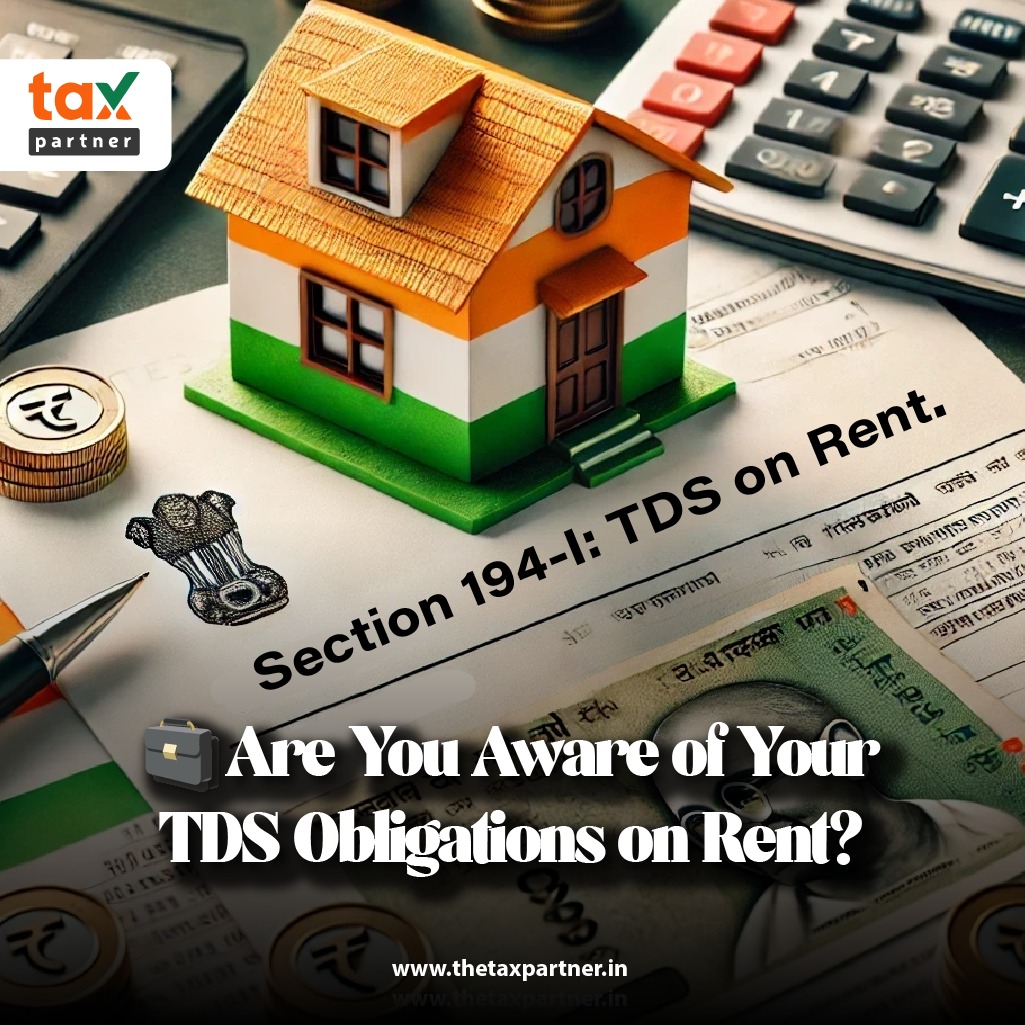Connect with us for all your queries



Tax Deducted at Source (TDS) is a mechanism that ensures tax collection at the source of income generation. Section 194-I of the Income Tax Act, 1961, specifically addresses the provisions for TDS on rent, which applies to individuals and entities paying rent for various assets like land, buildings, machinery, and furniture.
This article provides a comprehensive guide to understanding the implications and obligations under Section 194-I.
Section 194-I mandates that any person (other than an individual or a Hindu Undivided Family, unless they are subject to a tax audit) who is responsible for paying rent is required to deduct tax at source. The threshold for deducting TDS on rent is ₹2,40,000 per financial year for FY 2024-25. This threshold was previously ₹1,80,000 until FY 2018-19.
Additionally, individuals and HUFs not covered under tax audit but paying rent of ₹50,000 or more per month are obligated to deduct TDS under Section 194-IB.
TDS on rent should be deducted at the earlier of the following events:
The term ‘rent’ under Section 194-I is broadly defined to include any payment made under a lease, sub-lease, tenancy, or similar arrangement for the use of:
Even if these assets are sub-let, TDS on rent is applicable.
For individuals or HUFs not under tax audit, the following provisions apply:
Particulars
Applicability
Limit
Rate
ABC Pvt. Ltd. rents a building from Mr. Mohan, an individual, for ₹50,000 per month.
Details:
ABC Pvt. Ltd. should deduct ₹5,000 each month from the rent payment to Mr. Joy and deposit the total annual TDS amount of ₹60,000 to the government.
TDS on Rent for Machinery
XYZ Ltd. rents machinery from M/s. Equipment Rentals for ₹1,00,000 per month.
Details:
XYZ Ltd. should deduct ₹2,000 each month from the rent payment to M/s. Equipment Rentals and deposit the total annual TDS amount of ₹24,000 to the government.
TDS on Rent for Combined Building and Furniture
DEF Pvt. Ltd. rents a building and its furniture from Mr. Khan for ₹80,000 per month (₹60,000 for the building and ₹20,000 for the furniture).
Details:
DEF Pvt. Ltd. should deduct ₹8,000 each month from the total rent payment to Mr. Khan and deposit the total annual TDS amount of ₹96,000 to the government.
TDS on Rent When Paying to an NRI
GHI Ltd. rents a commercial property from Mr. Patel, a Non-Resident Indian (NRI), for ₹1,50,000 per month.
Details:
GHI Ltd. should deduct ₹45,000 (plus applicable surcharge and cess) each month from the rent payment to Mr. Patel and deposit it with the government.
Summary of Key Points
Section 194-I is a crucial provision ensuring that income from rent is brought into the tax net through TDS. Understanding the requirements and complying with them can help avoid penalties and ensure smooth tax filing. Individuals and businesses must stay informed about their obligations under this section to manage their tax liabilities efficiently.
1. What is Section 194-I of the Income Tax Act?
Answer: Section 194-I mandates the deduction of Tax Deducted at Source (TDS) on rent paid for the use of land, buildings, machinery, furniture, or other assets. It ensures that tax is collected at the source of income.
2. Who is required to deduct TDS under Section 194-I?
Answer: Any individual, firm, company, or other entities (except individuals and HUFs not subject to tax audit) making rental payments exceeding ₹2,40,000 annually is required to deduct TDS under Section 194-I.
3. What is the threshold limit for TDS under Section 194-I?
Answer: The threshold limit for TDS under Section 194-I is ₹2,40,000 per financial year. If the annual rent exceeds this amount, TDS must be deducted.
4. What are the applicable TDS rates under Section 194-I?
Answer: The TDS rates under Section 194-I are:
5. Is there any surcharge or cess applicable to TDS under Section 194-I?
Answer: No surcharge or cess is applicable to TDS deducted under Section 194-I for residents. However, if the rent is paid to a Non-Resident Indian (NRI), surcharge and cess may apply.
6. How is TDS calculated on rent paid to NRIs under Section 194-I?
Answer: When rent is paid to an NRI, TDS is deducted at a flat rate of 30% plus applicable surcharge and cess, irrespective of the threshold limit of ₹2,40,000.
7. What types of payments are covered under Section 194-I?
Answer: Section 194-I covers payments made for the use of land, buildings (including factories), machinery, plant, furniture, and fittings, whether furnished or unfurnished.
8. Are security deposits subject to TDS under Section 194-I?
Answer: TDS under Section 194-I is not applicable to refundable security deposits. However, if the deposit is non-refundable and is adjusted as rent, then TDS should be deducted.
9. What happens if TDS is not deducted under Section 194-I?
Answer: Failure to deduct TDS under Section 194-I may lead to disallowance of the expenditure in the computation of income under the Income Tax Act and may also attract interest and penalties.
10. When should the TDS deducted under Section 194-I be deposited?
Answer: The TDS deducted under Section 194-I should be deposited with the government by the 7th of the following month in which the deduction is made. For March, the due date is 30th April.
11. Is TDS under Section 194-I applicable to rent paid to government bodies?
Answer: Yes, TDS under Section 194-I is applicable even when rent is paid to government bodies unless a specific exemption is provided.
12. Can an individual be exempt from TDS deduction under Section 194-I?
Answer: Individuals and HUFs not subject to tax audit in the previous financial year are exempt from TDS deduction under Section 194-I.
13. Is TDS applicable on GST included in the rent under Section 194-I?
Answer: No, TDS should not be deducted on the GST portion of the rent if it is separately mentioned in the rent agreement or invoice.
14. How is TDS handled if the rent is paid in advance?
Answer: TDS under Section 194-I should be deducted at the time of credit of rent to the payee's account or at the time of payment, whichever is earlier, even if the rent is paid in advance.
15. How does the landlord receive the TDS deducted under Section 194-I?
Answer: The landlord can claim the TDS deducted under Section 194-I as a credit agai
nst their tax liability by reflecting it in their income tax return (ITR) using the TDS certificates (Form 16A) issued by the tenant.
Tax Partner is India’s most reliable online business service platform, dedicated to helping you in starting, growing, & flourishing your business with our wide array of expert services at a very affordable cost.